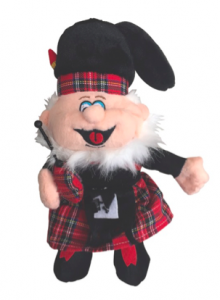 It’s a subject of great interest to many of the students who come to study with us here in Scotland why some Scotsmen wear what appears to be a woman’s skirt or dress. In most of Europe and North America only women wear skirts. However, in Africa, India and indeed parts of Europe and Asia, male “skirts”, in the form of a length of material, sometimes called a sarong, a veshti or mundu, are often worn. So why do we do it here?
It’s a subject of great interest to many of the students who come to study with us here in Scotland why some Scotsmen wear what appears to be a woman’s skirt or dress. In most of Europe and North America only women wear skirts. However, in Africa, India and indeed parts of Europe and Asia, male “skirts”, in the form of a length of material, sometimes called a sarong, a veshti or mundu, are often worn. So why do we do it here?
Scottie, as you may know, is one of the Schools’ mascots. He wears a kilt. In fact, he wears traditional “Highland Dress”, the combination of kilt, sporran, jacket, feather bonnet (hat), socks and shoes recognised across the world as “Scottish”. How Scottie – and the Scots – began to wear the kilt is a very interesting story…
The history of the kilt in Scotland goes back to the seventeenth century at least. Originally, it was a much bigger garment than the modern kilt. This “great kilt” was also called a “plaid”, and consisted of a large, woollen cloak which could be wrapped around the body. It was worn mainly in the Highlands – the northern, mountainous part of Scotland.
Nowadays, everyone associates the kilt with tartan cloth, with each different tartan identified with a family or “Clan”. However, in the earlier centuries different patterns (tartans) of cloth were associated with a region, not a Clan or family grouping. These ancient tartans were not really like the modern, more colourful tartans (like the one on Scottie’s kilt), which are a much more recent invention.
In the late eighteenth and early nineteenth centuries, the modern, shorter kilt evolved from the “great kilt”. Many people are surprised to discover that the modern kilt was invented by an Englishman, not a Scotsman! His name was Thomas Rawlinson and he came up with the idea of a shorter kilt in 1728 when he was living and working near Inverness. This new kilt was much easier to work in and soon became popular.
The Scots who lived in the lowland areas of the country began to wear the ‘short’ kilt and in the nineteenth century Queen Victoria, who loved coming to Scotland, helped make it even more popular by dressing her sons in it when they came to stay at Balmoral Castle in Aberdeenshire in the summer.
It was also in the nineteenth century that modern tartans – and their association with different Clans – began. Many people refer to this as the “Balmoralisation” of tartans, because the British royal family was very keen on Scottish culture and when they came to Balmoral Castle encouraged the wearing of “Highland Dress” amongst the Scottish gentry (the rich men who owned most of the land) and their families.
We’re not sure if Scottie is a member of the gentry or not, but he does look very smart in his kilt! If you haven’t been to Scotland before, it’s important to tell you that we don’t wear kilts all the time (unless we’re playing the bagpipes), but when you do come to study in Scotland, with any of our three Schools of English, you will see people wearing kilts and also hear the bagpipes. We’ll tell you a bit more about Scottie’s kilt, and about his bagpipes, in our next article.
Andrew Lennox, President, Glasgow School of English
 Glasgow School of English.
Glasgow School of English.